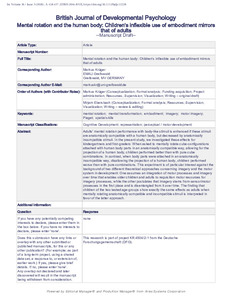Datum
2018Schlagwort
150 Psychologie RaumvorstellungKognitive EntwicklungKindMotorische EntwicklungExperimentelle PsychologieMetadata
Zur Langanzeige
Aufsatz

Mental rotation and the human body: Children's inflexible use of embodiment mirrors that of adults
Zusammenfassung
Adults’ mental rotation performance with body‐like stimuli is enhanced if these stimuli are anatomically compatible with a human body, but decreased by anatomically incompatible stimuli. In this study, we investigated these effects for kindergartners and first‐graders: When asked to mentally rotate cube configurations attached with human body parts in an anatomically compatible way, allowing for the projection of a human body, children performed better than with pure cube combinations. By contrast, when body parts were attached in an anatomically incompatible way, disallowing the projection of a human body, children performed worse than with pure combinations. This experiment is of specific interest against the background of two different theoretical approaches concerning imagery and the motor system in development: One approach assumes an increasing integration of motor processes and imagery over time that enables older children and adults to requisition motor resources for imagery processes, while the other postulates that imagery stems from early sensorimotor processes in the first place, and is disentangled from it over time. The finding that children of the two age groups tested show exactly the same effects as adults when mentally rotating anatomically compatible and incompatible stimuli is interpreted in favour of the latter approach.
Zitierform
In: British Journal of Developmental Psychology Volume 36 / Issue 3 (2018) , S. 418-437 ; eissn:2044-835XZusätzliche Informationen
This is the peer reviewed version of the following article: "Mental rotation and the human body: Children's inflexible use of embodiment mirrors that of adults", which has been published in final form at https://doi.org/10.1111/bjdp.12228. This article may be used for non-commercial purposes in accordance with Wiley Terms and Conditions for Use of Self-Archived Versions.Zitieren
@article{doi:10.17170/kobra-202103253601,
author={Krüger, Markus and Ebersbach, Mirjam},
title={Mental rotation and the human body: Children's inflexible use of embodiment mirrors that of adults},
journal={British Journal of Developmental Psychology},
year={2018}
}
0500 Oax
0501 Text $btxt$2rdacontent
0502 Computermedien $bc$2rdacarrier
1100 2018$n2018
1500 1/eng
2050 ##0##http://hdl.handle.net/123456789/13069
3000 Krüger, Markus
3010 Ebersbach, Mirjam
4000 Mental rotation and the human body: Children's inflexible use of embodiment mirrors that of adults / Krüger, Markus
4030
4060 Online-Ressource
4085 ##0##=u http://nbn-resolving.de/http://hdl.handle.net/123456789/13069=x R
4204 \$dAufsatz
4170
5550 {{Raumvorstellung}}
5550 {{Kognitive Entwicklung}}
5550 {{Kind}}
5550 {{Motorische Entwicklung}}
5550 {{Experimentelle Psychologie}}
7136 ##0##http://hdl.handle.net/123456789/13069
<resource xsi:schemaLocation="http://datacite.org/schema/kernel-2.2 http://schema.datacite.org/meta/kernel-2.2/metadata.xsd"> 2021-08-03T15:35:23Z 2021-08-03T15:35:23Z 2018 doi:10.17170/kobra-202103253601 http://hdl.handle.net/123456789/13069 This is the peer reviewed version of the following article: "Mental rotation and the human body: Children's inflexible use of embodiment mirrors that of adults", which has been published in final form at https://doi.org/10.1111/bjdp.12228. This article may be used for non-commercial purposes in accordance with Wiley Terms and Conditions for Use of Self-Archived Versions. eng Urheberrechtlich geschützt https://rightsstatements.org/page/InC/1.0/ mental rotation mental transformation embodiment imagery motor imagery Piaget spatial skills 150 Mental rotation and the human body: Children's inflexible use of embodiment mirrors that of adults Aufsatz Adults’ mental rotation performance with body‐like stimuli is enhanced if these stimuli are anatomically compatible with a human body, but decreased by anatomically incompatible stimuli. In this study, we investigated these effects for kindergartners and first‐graders: When asked to mentally rotate cube configurations attached with human body parts in an anatomically compatible way, allowing for the projection of a human body, children performed better than with pure cube combinations. By contrast, when body parts were attached in an anatomically incompatible way, disallowing the projection of a human body, children performed worse than with pure combinations. This experiment is of specific interest against the background of two different theoretical approaches concerning imagery and the motor system in development: One approach assumes an increasing integration of motor processes and imagery over time that enables older children and adults to requisition motor resources for imagery processes, while the other postulates that imagery stems from early sensorimotor processes in the first place, and is disentangled from it over time. The finding that children of the two age groups tested show exactly the same effects as adults when mentally rotating anatomically compatible and incompatible stimuli is interpreted in favour of the latter approach. open access Krüger, Markus Ebersbach, Mirjam doi:10.1111/bjdp.12228 Deutsche Forschungsgemeinschaft (DFG). Grant Number: KR 4504/2‐1 Raumvorstellung Kognitive Entwicklung Kind Motorische Entwicklung Experimentelle Psychologie acceptedVersion eissn:2044-835X issn:0261-510X Issue 3 British Journal of Developmental Psychology 418-437 Volume 36 false </resource>
Die folgenden Lizenzbestimmungen sind mit dieser Ressource verbunden:
Urheberrechtlich geschützt

